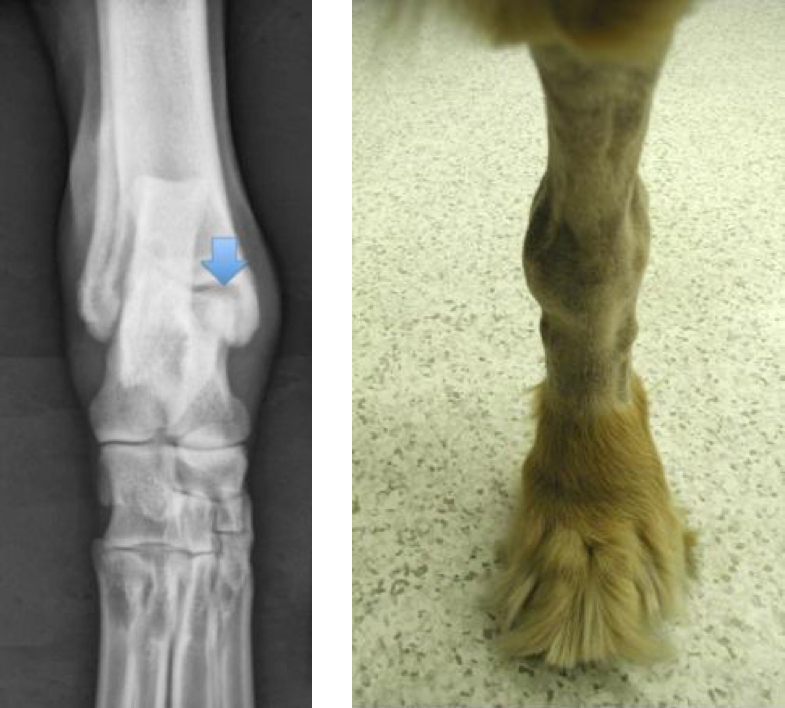Laurie's Blogs.
Mar 2019
Tarsal OA

I don’t blog much about the tarsus. Maybe it’s time to talk tarsal joints! Why the sudden interest? Well, in going through some journal articles, I found one that was a Systematic Review and Meta-Analysis regarding physical impairments in (human) Adults with Ankle Osteoarthritis.
Essentially, of all of the studies they found, only 8 qualified for review, and of those, only 3 could be used for a meta-analysis. Despite this, they found that there were large impairments of ankle ROM and strength in the sagittal plane. Some single studies described impairments in the frontal plane of motion and strength, as well as deficits in talar translation and rotation, balance, and electromyography of ankle joint muscles. Additionally, there were reports of abnormal bony alignments and greater fatty infiltrate in all calf muscle compartments. (Al-Mahrouqi et al 2018)
But what is out there in the canine literature?
- Arthroscopy of the tibiotarsal joint can be used to help detect and subsequently treat OCD, collateral ligament injury, fractures, septic & non-septic arthritis. However, long term tibiotarsal DJD advancement is seen. With OA of the joint, there is reduced weight bearing of the limb and radiographic progression of DJD (Miller & Beal 2008).
I was all set up with a bullet point for # 2, and well, there was nothing else in the literature that I could find! Crazy, right?? I could find other studies about surgical techniques, progression of degenerative joint disease, arthroscopic findings. No biomechanics studies at all.
So, let me think out load for you on this subject.
- •Tarsal OA (tibiotarsal, inter-tarsal, tarsometatarsal) … not sure it matters which of these it would be. There might be discreet differences in kinematics, but not likely large ones.
- •OA tarsals begin to lose flexion (especially if the tibiotarsal joint is affected). As such, these dogs won’t sit squarely and will likely choose to ‘side sit’). Thus, making the muscular burden for power or control of their sit to stand reliant upon the contralateral hind leg or the front legs.
- •OA in a hind limb (anywhere) is likely to reduce weight bearing, stance time, and peak vertical force. I will also speculate it reduces reach and drive of that leg as well.
If I’m right about this… then the other physical things to look for in the canine patient would be compensations such as:
- •Myofascial trigger points in the Iliopsoas, Sartorius, and Tensor Fascial Lata muscles (as they may keep the limb off-loaded slightly.
- •Potential SIJ dysfunction or pelvic asymmetry. I think I might find what appears to be a dorsally rotated ilium on the affected side, for the same reason as mentioned above.
- •Off-loading of the affected leg could also affect the lumbar spine. With stifle injuries, I often find L5 – L7 tender on palpation. I’d expect the same with the tarsus as well.
- •Secondary to increase ‘front end’ loading (pulling themselves up, and pulling themselves to propel forwards), the thoracic spine and ribs may also become sore, along with the latissimus dorsi and teres major muscles.
- •Perhaps the contralateral rear leg could develop overuse injuries, or the front diagonal limb. It really all depends on how the dog compensates and alters its movement strategies. Worth checking all 3 unaffected limbs!
- •Might there be fascial restrictions? I’d check the ‘lateral lines’ and ‘frontal (ventral) lines’ in various combinations.
What’s my point with all of this? Well, firstly you want to treat the tarsal OA joint with local therapies (i.e. modalities, mobilizations). You’ll want to be prescribing exercise (because it’s been shown to help OA knees and hips, so why not the tarsus?). Then you may find that much of what you can do ‘in clinic’ would be looking for and treating the compensations listed above, thereby creating the comprehensive treatment approach for your patient.
If you have thoughts on this, please feel free to pass them along to me. I’d be happy to hear them or brainstorm further!
References
- Al-Mahrouqi MM, MacDonald DA, Vicenzino B, Smith MD. Physical Impairments in Adults With Ankle Osteoarthritis: A Systematic Review and Meta-analysis. Journal of Orthopaedic & Sports Physical Therapy 2018 48:6, 449-459.
- Miller J, Beale B. Tibiotarsal arthroscopy. Applications and long-term outcome in dogs. Vet Comp Orthop Traumatol. 2008;21(2):159-65.


